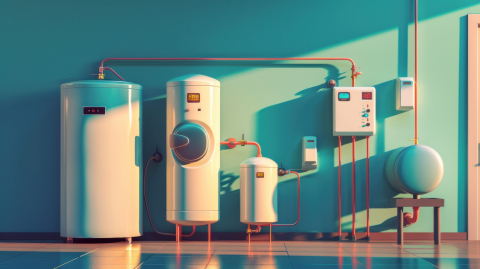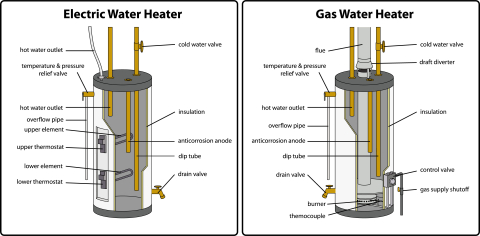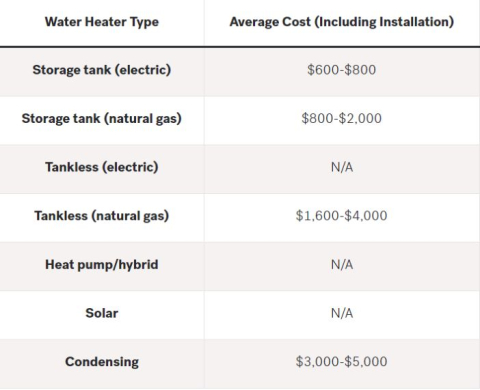
Water Heater Tanks


A hot water tank is used to store and heat water for cooking, cleaning, drinking, and bathing. Every home has one and if you are in the market for a new water heater, there are a few to choose from. Which one is best for you and your home all depends on you and your home and the size of your family.
On average, the lifespan of a hot water tank is around eight to twelve years, and fifteen if maintained properly. The water heater is usually located in the basement. A cylinder-shaped tank with heat insulation is built in, but you can also buy extra insulation if needed. Water heater tanks come in four different types for residential uses:
- Tank type (type mostly used)
- Tankless water heater. (gaining popularity)
- Hybrid models (maximum energy efficiencies)
- Point of Use (for appliances far away or with no access to the main water heater)
Water tanks are powered by gas, oil, propane, or electricity. Gas-powered water tanks are the most common. Most water heater tanks have:
- Tank
- Dip tube
- Shut-off valve
- Heat out pipe
- Thermostat
- Heating mechanism
- Drain valve
- Pressure relief valve
- Sacrificial anode rod
If any of these break or if your water is not warm or doesn't have enough pressure, you may need to replace the pieces or maybe the whole water heater tank.
How do Water Heaters work?
The tank holds hot water until it is needed. When you turn on the hot water taps to use the hot water for washing the dishes or even just your hands, etc., as the tank empties, cold water enters the tank through a tube at the bottom of the tank, while a built-in thermostat monitors the water temperature. While the cold water is added, the main gas valve opens, and air mixes in with the gas, igniting the main burner, and heating the water back up to its set temperature. Water is released to the taps or appliance that is being used and more cold water is added to the tank to be warmed. As the water warms, the exhaust fumes exit the tank through the flue vent.

How to maintain your water heater.
Maintaining your water heater is always a good idea to ensure it is working properly.
- Check for leaks
- Flushing the tank
- Test the temperature and pressure relief valve
- Inspection of the area
- Keeping the area around the water heater clean
- Inspect for corrosion anywhere (rusted metal)
Signs your water heating is breaking down.
Repairing your water heater can be expensive. It is one of the most used appliances at home, as it heats the water we use every day. Maintaining your water heater to ensure it lasts longer and works properly is very important. However, sometimes objects can get wear and tear and break down as time goes by. Here are some tips to know if your water heater needs replacing:
- No hot water for bathing or cleaning
- Check for any leaks including the valves and pipes.
- Inconsistent water temperature – if your hot water runs from hot to cold without turning anything up or down, you may have a problem with the thermostat or heating elements.
- Poor water pressure – Sediment (build-up of rust, hard water minerals, and dirt) build-up can limit the amount and pressure of water from your water tank. Regular flushing can help.
- Suspicious sounds – if your water heater starts making loud banging, or unusual noises, you may need to have a professional come and inspect the problem. it may be able to be repaired or you’ll have to replace it.
- Water discoloration – if you notice your water looking or tasting different, check the other taps in the house too. It may be the pipes. If it's happening throughout the home and not just one area, it’s most likely the water heater.

What to consider when buying a new Water Heater
You can always speak with a professional if you’re unsure which size to buy for your home. Seeking help from a professional can help you with which options to consider. Ask the professional about what kind of heat source you have available, capacity, venting, efficiency, and space. Depending on where you live, gas may not be available. Some areas use propane or oil. The capacity of the tank depends on how many people are in your home and how long people are using the shower. The cost of a water heater does include installation, warranty, and the required license for installation. Some service providers may offer incentives or rebates to upgrade your water heater for better energy efficiency.

If you do suspect a gas leak (natural gas contains an additive that makes it smell like rotten eggs), call a professional right away. If you do have a leak or any other issue the professional deems unsafe, you may get a red tag. A red tag indicates that your equipment may be a threat to the household, putting you and your family at risk. There are two types of tags. Type A means your appliance is in immediate danger and your natural gas will be shut off to prevent carbon monoxide or any other poisonous gasses or hazards to your health. Type B means that your appliance has issues but can have up to 30 days to replace. Regular inspections can help prevent any major health hazards.
The higher the capacity of a water heater tank means more hot water for everyone in the home. If you have a larger family, it may increase the energy or water bill but upgrading to a larger capacity water heater will improve your unit's performance. Conventional water heater tanks are easy to install especially if it’s the same brand. Switching from electric to gas heaters or hybrids (heat pumps) will also cost more because you will have to add some piping work and venting work to your home. Speaking with a professional may be the right step if you are unsure of which water heater would be best for you, your home, and your family.
By: Tricia Cook, Content Navigator